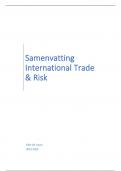Summary
Full Summary of International Trade & Risk 2023/2024 (ppts + lesson notes)
- Course
- Institution
This is a complete summary of the international trade & risk course at Artevelde University in the field of International Business (AJ). Disclaimer: copy from ppts and lesson notes included (no book for this course)
[Show more]



